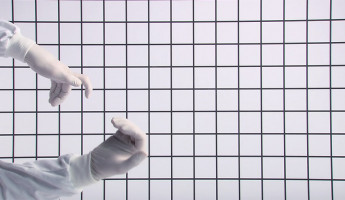hands on
two channel video installation, 2014
intro
In the video work “hands on (vers. 3)”, dated 2014, the viewer is brought into a space reminiscent of a laboratory. The black and white grid that serves as a background on both channels is a reference to the classical frames of chronophotography and to the tiles typically seen in the laboratory for molecular medicine. This space becomes the scene of the action, action that is limited to the shadow-like movements of two hands.
installation view
Quasicrystals or the Harmony of Illusion, Exhibition center Heiligenkreuzerhof, Vienna/A 2014
photo: © Gebhard Sengmüller
top right:
artists studio, Vienna, 2014
photo: © Herwig Turk
bottom left:
Landscape = Laboratory, MMKK, Klagenfurt/A 2016/17
photo: © Gebhard Sengmüller
bottom right:
WRAPPED IN CODE, NODE15 Forum for digital Arts, Mousonturm, Frankfurt/G, 2015
photo: © NODE15
text
Herwig Turk : hands on (vers. 3) 2014
In the video work “hands on (vers. 3)”, dated 2014, the viewer is brought into a space reminiscent of a laboratory. The black and white grid that serves as a background on both channels is a reference to the classical frames of chronophotography and to the tiles typically seen in the laboratory for molecular medicine. This space becomes the scene of the action, action that is limited to the shadow-like movements of two hands. As if on a stage, the hands become actors – the sole actors here, garbed in tightfitting protective gloves and the sleeves of the obligatory white lab smock.
The minimized visual arrangement totally focuses the viewer’s attention on what is implicitly known by the person whose hands are in motion and present, somehow, in the gestures of these hands. The hands in motion were filmed in the studio by two cameras and can thus be viewed both frontally and in high-angle shot at the same time on two video screens, one mounted horizontally and the other vertically. In this way, the installation follows filming procedures that are used for laboratory test set-ups and that serve to produce so-called utility films for the purposes of research in the natural sciences.







